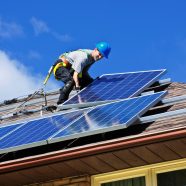
It has become a common sight in the Sunshine State, to see solar panels on the roofs of homes and businesses. After all, with all that sunshine, it makes sense to take advantage of the energy savings and energy efficiency benefits that going fully or partly off grid offers, and what better way than to harvest sunshine!
Whether you’re interested in green building in general, or just considering retrofitting your home with solar panels to take advantage of energy savings and lower utility bills, you might have wondered how it all works. So we decided to give you the short and simple version of how solar panels work, and here it is.
Solar Panel Basics
The solar panels that power homes and businesses are known as photovoltaic or PV panels. There are other types of solar panels, such as thin film, and other methods of collecting solar energy like parabolic troughs, but if you’re going off grid, it’s PV panels that will do the work for you.
Solar panels work by creating an electrical field, by sandwiching two layers of silicon together, and by treating each of those layers to manipulate them into having a particular charge. The top layer will be treated with phosphorous, to add electrons, and create a negative charge, while the bottom gets added boron, which removes electrons, and creates a positive charge.
With the electrical field established, photons from sunlight can “knock electrons loose” and those electrons are then collected, and become electricity.
The Complicated Stuff
When you look at PV solar panels in such a basic, fundamental way, it can be difficult to understand why it costs so much to convert your home, get energy savings and conserve energy. However, there is a lot more to a solar power system for a building than just the panels (and even those are complex to design and manufacture.)
First, there’s the issue of the type of power that has been generated. Our homes run on what is known as AC, or Alternating Current, but the power that comes from a PV panel is DC, or Direct Current. Since the two don’t mix, the first thing that needs to happen is to use a piece of equipment called an inverter to convert the DC current into usable AC power.
There’s usually also a piece of equipment called a regulator installed early on in the solar power system. This piece of equipment helps to ensure that the power from your solar panels isn’t too much for your batteries or panel to handle.
Next, there are usually batteries, which are typically deep cycle batteries, which store the electrical power collected by the solar panels, since there is no power generated at night, and your home will still need to have power when it’s dark!
Finally, there’s the connection to your electrical panel, utility meter, and in some cases, the main grid.
Solar panels also need to be carefully oriented to collect sunlight efficiently, and there are many other considerations that need to be made. In short, while the principles of solar power are not too complicated, the systems can be, and if you’re thinking about going off grid, it’s always a good idea to talk to an electrical contractor who has some experience!

Recent Comments